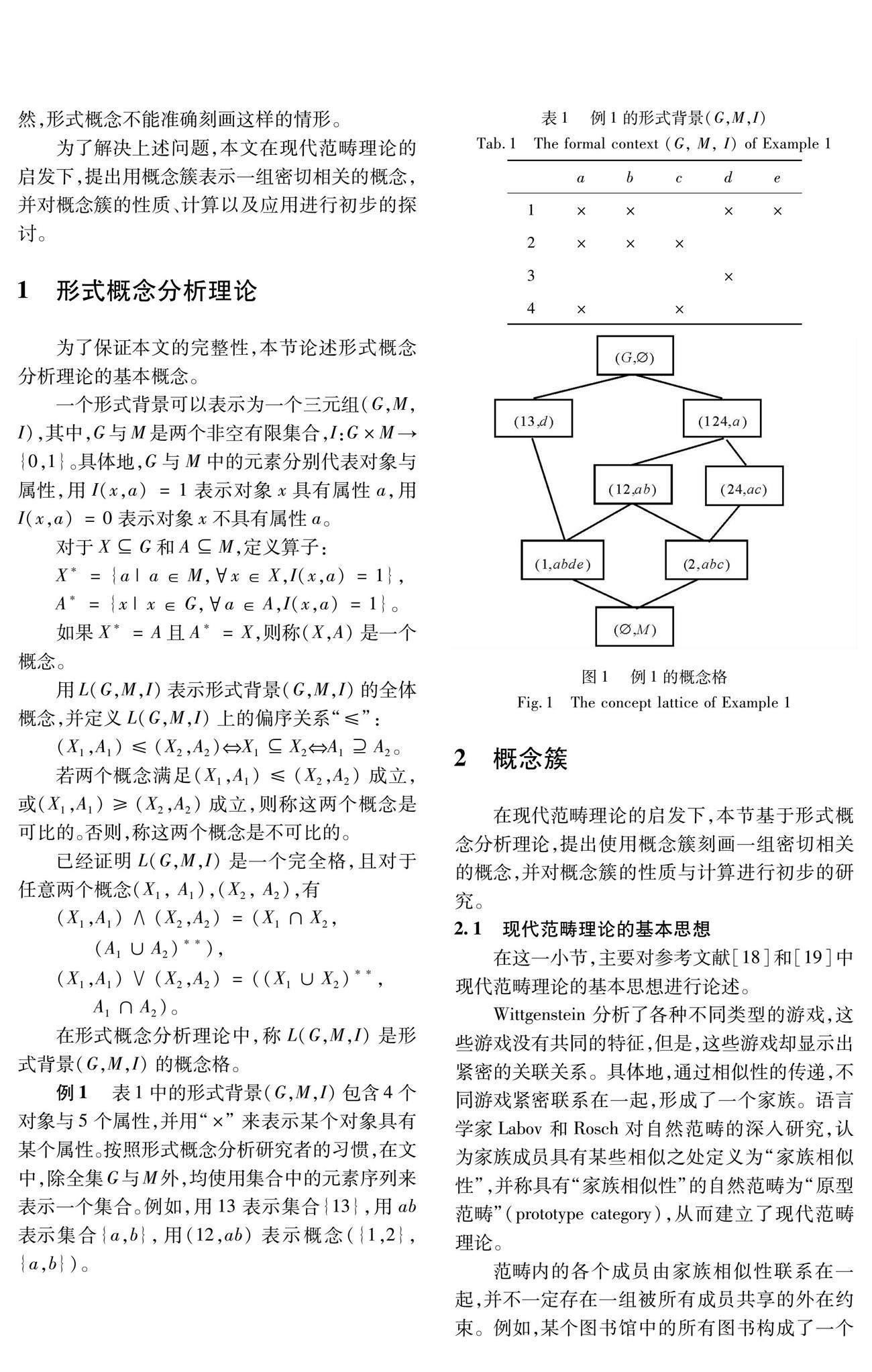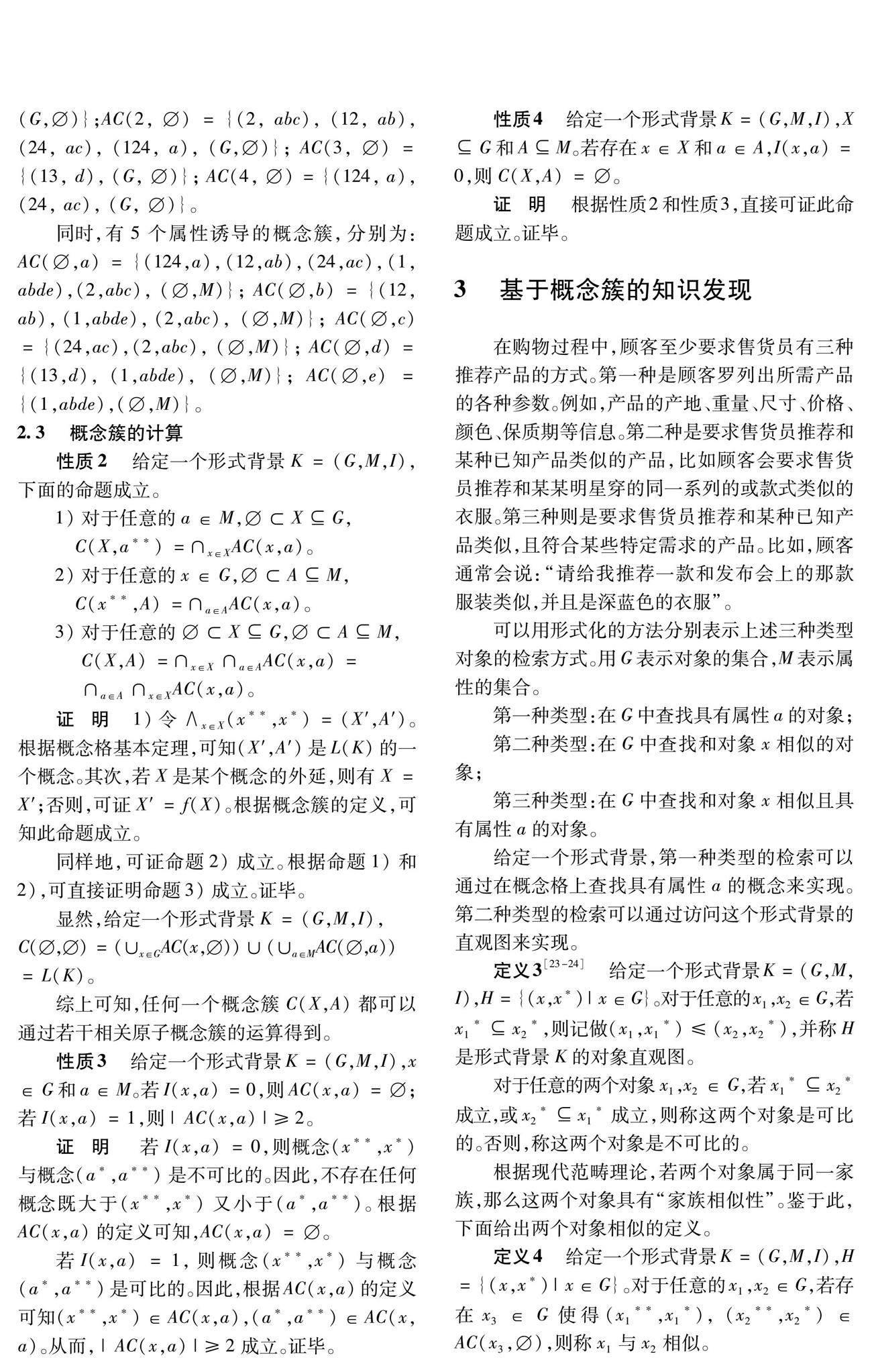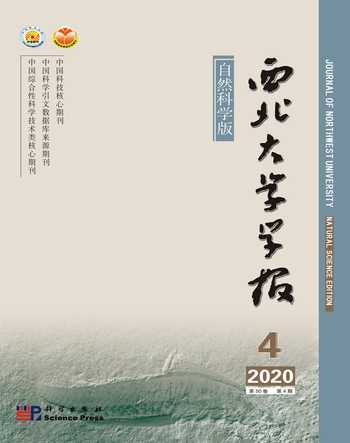基于概念簇的知识表示
2020-04-29智慧来李逸楠
智慧来 李逸楠



摘要:概念是信息粒化过程中的重要粒度之一。然而,基于概念的知识表示并不能有效地对具有家族相似性的原型范畴进行刻画。该文在现代范畴理论的启发下,提出用概念簇表示一组密切相关的概念,以刻画粒度大于概念的信息粒。其次,研究了概念簇的若干重要性质与计算方法。最后,提出了一种基于概念簇的信息检索方法。
关键词:形式概念分析;粒計算;概念簇;知识表示
中图分类号:TP18
DOI:10.16152/j.cnki.xdxbzr.2020-04-003开放科学(资源服务)标识码(OSID):
Knowledge representation based on concept cluster
ZHI Huilai, LI Yinan
(School of Computer Science & Technology, Henan Polytechnic University, Jiaozuo 454003, China)
Abstract: Concept is one of the important granularities in the process of information granulation. However, concept-based knowledge representation cannot effectively describe prototype category with family similarity.Inspired by the modern category theory, this paper proposes to concept cluster to represent a group of closely related concepts, so as to depict information
granules with granularities larger than concepts. And then, some important properties and calculation methods of concept clusters are studied. Finally, an information retrieval method based on concept cluster is proposed.
Key words: formal concept analysis; granular computing; concept cluster; knowledge representation
在大数据潮流下,粒计算提供了知识发现和从人工智能到机器实现的有效方法[1-2]。信息粒化是采用粒计算思想解决问题的前提。在具体问题中,大小各异的粒形成了粒度链条[3],人们主要通过粒之间的转换、推理以及相互交互来实现问题的求解[4-6]。
形式概念分析[7-8]是一种最为有效的粒计算方法。面向特定的数据分析与知识发现的需要,通过构造性方法可以得到一系列不同种类的概念[9-13],从而满足不同的应用需求。近年来,粗糙集、粒计算、模糊集、三支决策理论等与形式概念分析融合发展,在基于知识的信息处理等相关领域产生了一大批理论与应用成果[14-17]。
然而,以概念作为基本粒度的知识发现并不能有效地对具有家族相似性的原型范畴进行刻画。实质上,这是由于整个粒度链条没有得到彻底的研究,位于粒度链条顶端的子格在应用中没有得到应有的重视。
现代范畴理论[18-19]强调家族相似概念,不具有共同属性的对象仍然可能属于同一范畴。显然,形式概念不能准确刻画这样的情形。
为了解决上述问题,本文在现代范畴理论的启发下,提出用概念簇表示一组密切相关的概念,并对概念簇的性质、计算以及应用进行初步的探讨。
4 结 语
概念簇是一组具有“家族相似性”的概念构成的信息粒,本质上是概念格的一个子格。概念簇的提出使得子格从概念认知的角度得到阐释,且符合现代范畴理论的主要思想。
概念簇作为信息粒化过程中的重要粒度之一,还有许多有待深入研究的问题。例如,不确定环境下的概念簇如何定义,与经典二值形式背景下的概念簇有何区别与联系;概念簇与概念格中的不可约概念有什么联系;概念簇在三支概念分析的背景下具有哪些重要的性质;概念约简对概念簇结构有什么影响。
最后需要指出的是,概念簇与概念格密切关联,概念格的结构复杂性制约了应用的有效性。因此,有关概念簇的研究还需要付出更多的努力。
参考文献:
[1] 徐计,王国胤,于洪. 基于粒计算的大数据处理[J].计算机学报,2015, 38(8): 1497-1517.
XU J, WANG G Y, YU H. Review of big data processing based on granular computing[J].Chinese Journal of Computers, 2015, 38(8): 1497-1517.
[2] 梁吉业, 钱宇华, 李德玉,等. 大数据挖掘的粒计算理论与方法[J].中国科学F辑:信息科学, 2015, 45(11):1355-1369.
LIANG J Y, QIAN Y H, LI D Y, et al. Theory and method of granular computing for big data mining [J].Science in China Series F: Information Sciences, 2015, 45(11):1355-1369.
[3] QI J J, WEI L, WAN Q. Multi-level granularity in formal concept analysis [J]. Granular Computing, 2019, 4(3):351362.
[4] ZADEH L A. Toward a theory of fuzzy information granulation and its centrality in human reasoning and fuzzy logic[J]. Fuzzy Sets and Systems, 1997, 90(2):111-127.
[5] FUJITA H, GAETA A, LOIA V, et al. Resilience analysis of critical infrastructures: A cognitive approach based on granular computing[J]. IEEE Transactions on Cybernetics, 2019, 49(5): 1835-1848.
[6] HONKO P. Recent granular computing frameworks for mining relational data[J]. Artificial Intelligence Review, 2019, 52(4): 2705-2742.
[7] FERR S, CELLIER P. Graph-FCA:An extension of formal concept analysis to knowledge graphs[J]. Discrete Applied Mathematics, 2020, 273: 81-102.
[8] 李金海, 吳伟志. 形式概念分析的粒计算方法及其研究展望[J].山东大学学报(理学版), 2017,52(7):5-16.
LI J H, WU W Z. Granular computing approach for formal concept analysis and its research outlooks[J].Journal of Shandong University(Natural Science), 2017, 52(7): 5-16.
[9] QI J J, QIAN T, WEI L. The connections between three-way and classical concept lattices[J]. Knowledge-Based Systems, 2016, 91: 143-151.
[10]ZHI H L, QI J J, QIAN T, et al. Three-way dual concept analysis[J]. International Journal of Approximate Reasoning, 2019, 114: 151-165.
[11]WANG L D, LIU X D. Concept analysis via rough set and AFS algebra[J].Information Sciences, 2008, 178(21): 4125-4137.
[12]SHE Y H, HE X L, QIAN T, et al. A theoretical study on object-oriented and property-oriented multi-scale formal concept analysis[J]. International Journal of Machine Learning and Cybernetics, 2019, 10(11): 3263-3271.
[13]KONECNY J. Attribute-oriented fuzzy concept lattices and standard fuzzy concept lattices induce the same similarity on objects[J]. Fuzzy Sets and Systems, 2016, 294: 136-140.
[14]魏玲,曹丽,祁建军,等.形式概念分析中的概念约简与概念特征[J/OL].中国科学:信息科学,https:∥doi.org/10.1360/N112018-00272.
WEI L, CAO L, QI J J, et al. Concept reduction and concept characteristics in formal concept analysis[J/OL].Science China: Information Sciences, in press,https:∥doi.org/10.1360/N112018-00272.
[15]YAO Y Y. Rough-set concept analysis:Interpreting RS-definable concepts based on ideas from formal concept analysis[J]. Information Sciences,2016,346/347:442-462.
[16]WU W Z,LEUNG Y,MI J S.Granular computing and knowledge reduction in formal contexts [J]. IEEE Transactions on Knowledge and Data Engineering,2009,21(10):1461-1474.
[17]ZHI H L, QI J J, QIAN T, et al. Conflict analysis under one-vote veto based on approximate three-way concept lattice[J].Information Sciences,2020,526:316-330.
[18]CROFT W, CRUSE D A. Cognitive Linguistics[M].Cambridge: Cambridge University Press. 2004.
[19]WAXMAN S.Woman,Fire,and Dangerous Things:What Categories Reveal About the Mind[M].George Lakoff.Chicago:University of Chicago Press,1987.
[20]邓大勇, 卢克文, 苗夺谦,等. 知识系统中全粒度粗糙集及概念漂移的研究[J]. 计算机学报, 2019, 42(1): 85-97.
DENG D Y, LU K W, MIAO D Q, et al. Study on entire-granulation rough sets and concept drifting in a knowledge system[J]. Chinese Journal of Computers, 2019, 42(1): 85-97.
[21]GANTER B, KUZNETSOV S O. Hypotheses and version spaces[J].Lecture Notes in Computer ence, 2003,2746:83-95.
[22]ZHI H L, LI J H.Granule description based on formal concept analysis[J]. Knowledge-Based Systems, 2016, 104:62-73.
[23]WEI L, WAN Q. Granular transformation and irreducible element judgment theory based on pictorial diagrams[J]. IEEE Transactions on Cybernetics,2016, 46 (2):380-387.
[24]ZHI H L, LI J H. Granule description based knowledge discovery from incomplete formal contexts via necessary attribute analysis[J]. Information Sciences, 2019, 485:347-361.
(編 辑 张 欢)
作者简介:
智慧来,男,1981年生,河南偃师人,博士,副教授。2010年毕业于上海大学,获工学博士学位,主要从事粒计算、形式概念分析、粗糙集等方面的研究。主持完成国家自然科学基金(青年基金)1项,以第一作者在计算机学报,电子学报,Information Sciences,Knowledge-Based Systems,International Journal of Machine Learning and Cybernetics,International Journal of Approximate Reasoning,Granular Computing等国内外期刊发表学术论文20余篇,获发明专利1项、软件著作权2项,在科学出版社出版专著1部,获河南省自然科学优秀论文一、二、三等奖各1项。
